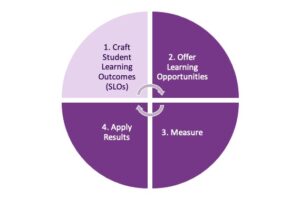Student Learning Outcomes (SLOs) articulate the “desired results” that you have identified in backward design–they express what learners will know and be able to do when they complete a course, degree program, or other learning opportunity. Outcomes center students in learning experiences, reveal how to cultivate and retain learning, create connections across learning opportunities, and begin to shift students’ transactional views of education into lifelong learning and growth mindset. Vertical outcome alignment clarifies how each assignment, course, and program work together to operationalize UMBC’s institutional-level outcomes and mission. To learn more, visit Why are SLOs Important?
For detailed instructions and examples see A Guide to Curriculum Mapping: Creating a Collaborative, Transformative, and Learner-Centered Curriculum (Harrison & Williams 2024), or request a consultation or workshop.
Student-Centered Student Learning Outcomes
The learning assessment cycle begins with student learning outcomes (SLOs). To craft clear, transparent SLOs, we write from the students’ learning perspective: what specifically will students know and/or be able to do when they complete this assignment, course, or degree program?
Student Learning Outcomes typically include …
- a time-framed statement, such as “After completing this course (or program), students will be able to …,”
- followed by a numbered list of outcomes, each clearly stated with:
- an action learning verb,
- the concept or skill students will learn, and,
- sometimes, a “by” phrase identifying an action or deliverable that demonstrates the results.
When the deliverable is not stated in the outcome, it is typically expressed in the assignments or other learning demonstrations. When you’re ready to write SLOs for your course or program, visit our SLOs Step By Step page for details.
Examples
In addition to the examples below, please see the resources below for example outcomes from many disciplines and levels.
After completing this course, students will be able to:
- identify current environmental approaches to mitigating greenhouse gasses by analyzing key research,
- evaluate resources that propose new solutions,
- demonstrate collaboration skills by presenting a team-created application of one environmental solution, and
- translate environmental science research into everyday language by crafting a public service campaign.
(In example two above, the deliverable is inferred.)
We recommend that you share outcomes for programs (on your website) and courses (on your syllabus) with your students.
Resources
- NILOA Transparency Framework examines how to craft transparent SLOs that are specific, clear, shared on the website, updated regularly, and open to feedback and comments.
- Degree Qualifications Profile (DQP) can help you visualize learning at different degree levels.
- Essential Learning Outcomes (ELOs) from AAC&U.
- Backward Design explains this planning process including formulating “desired results.”
Need help writing or revising your SLOs? Please contact us
FDC Learning Assessment Resources | Curriculum Mapping | Direct Measures: Rubrics & Tests | Closing the Loop | Selected Learning Assessment References
Text and graphics created by Jennifer M. Harrison, Ph.D.